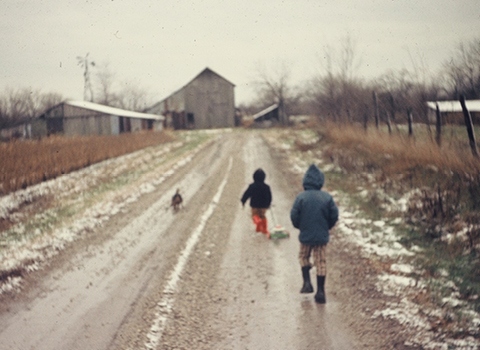
Bruce Family Farm, c. 1973
Tim Bruce builds model churches that aren’t exactly places of worship and prototypical boats that aren’t very seaworthy. That’s OK because, really, they’re about his grandfather’s barns.
The constructions are made from wood he salvages out of Chicago alleys and the Michigan countryside, and from the old tin signs he has collected for years. His churches are ornate, some cathedral like and others modest in floor plan, but all elaborately decorated. The signs, incorporated as roofs or walls, provide most of the shine. The wood’s surfaces are typically not bright, though still vivid in a dark sort of way, occasionally gloomy but never dull.
The boats, like the churches, are quite large, two to three feet long, with the signs serving as hulls or sails. There is often wire rigging, with dense wood patterns built up on the sides and decks and complex bits of structure running the length of the ship. This all provides a convincing level of detail if not actual verisimilitude.
Bruce has been producing these objects for about 8 years now — for “the making,” he says. “Part of the reason I started them is that I wanted to make things by hand.”
Although Bruce is not otherwise a sculptor or painter, he is a graphic artist who operates a successful design firm in Chicago. That means he has a professional interest in things like typography and graphically striking shapes and patterns. In fact, he collected old signs long before he started making things from them. The vintage type styles and advertising graphics provided inspiration and source material for his design practice.
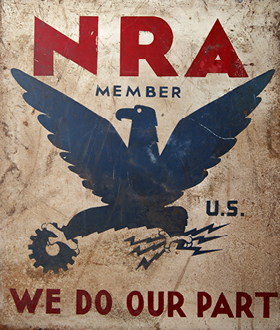
Sign: National Reconstruction Act, 1930s
Now the signs provide a framework for his constructions, which start with the signs, he says, suggesting the color and overall shape of what he builds. The message content is usually beside the point – if you look at a sign closely enough, you see forms and colors rather than words. That doesn’t exclude the content from occasionally being incorporated into the creations, though not necessarily with any particular reference to the piece. For example, on one of his boats the front sail is an Indian sign promoting Tekka safety matches while a second sail advertises British fire and marine insurance, a small joke that is incidental to the boat itself.
Bruce’s collecting interests extend beyond old signs to folk and outsider art. His home is full of paintings and sculpture by self-taught artists, some of them resonant with his own constructions.
The most obvious example is Aldo Piacenza, an Italian immigrant and shop keeper who lived in suburban Chicago. He painted urban scenes and landscapes and built wooden church models inspired by his native country. Bruce says that Piacenza’s influence on him is less from the artist’s birdhouse churches, two of which he owns along with a painting of the Vatican, than from the intensity with which Piacenza expressed his memories, in his paintings as well as his constructions.
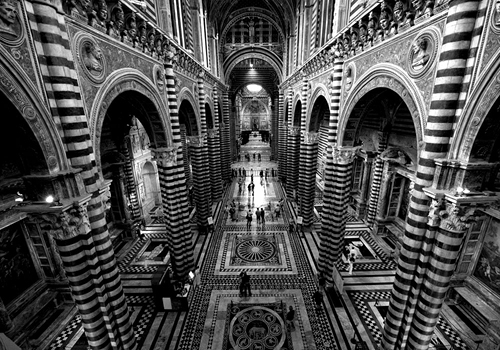
Siena Duomo, Italy
Memory, Bruce says, is the most compelling factor in his own work. Crucial recollections include the old-world churches and shipyards he saw as a young man while studying abroad in Newcastle, England. The cathedral in Siena had a particular impact with its mesmerizing black-and-white patterns inside and out.
The biggest influence, though, was his grandfather’s farm, where as a child he played in old barns that he grew to love. The often-complex arrangements of the old barn wood and the make-do creativity with which the buildings were maintained, or even built, left lasting impressions.
In lieu of spending scarce cash for new materials, barns and outbuildings were often patched with scrap wood and old metal signs that were lying around the farm. “This is what my grandpa did,” Bruce says. “They were always saving everything and making it into something else.”
Not coincidentally, from his other grandfather he inherited another make-do creation—a homemade workbench with drawers fabricated from old signs and Eskimo Pie crates.
Repurposing scavenged materials is also very much in the tradition of the self-taught artists Bruce collects, who often use whatever they have on hand rather than professional art supplies to make their drawings, paintings and sculptures.
Bruce says his own pieces are “like drawing with stuff. They’re not perfect.”
His use of crooked, bent, broken bits doesn’t supply a high degree of precision. “In design you work to eliminate the imperfections,” he says. “This is the reverse.”
His pieces can sometimes seem unwieldy, even ungainly, but their heft isn’t merely physical. There is an almost spiritual presence to some of them—they project a latent energy that forms a powerful connection with viewers.
But why does Bruce try to make that connection via churches rather than barns? Churches are more distinctive architecturally, he says. The abundant design features and variations in their construction provide more scope for his imagination than the more straightforward architectural footprint of barns.
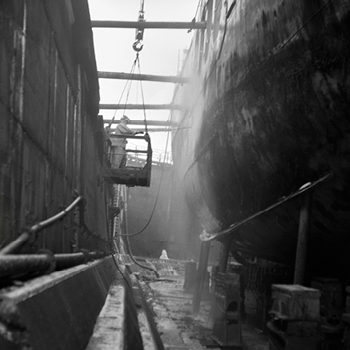
Ship repair, Newcastle Upon Tyne, UK.
Photograph by Richard Smith, c. 1991
And boats? He made his first one, he says, because he had a piece of metal too large for one of his buildings. So he bent it and created a ship’s hull, then added the other bits that made it look like a boat. He’s since made several more, even though the boats take longer than the buildings to produce.
In all cases his focus is the visual presence of the object he is creating as opposed to making a model of something that actually exists.
“I make it up,” he says. “The sign makes it. I start with the signs and they suggest the form somehow.”
The objects are obviously influenced by the real-world memories rolling around in his consciousness, but they are ultimately fantasies of what they look like. Being unmoored to actual examples gives Bruce a freedom to create more drama in his structures, with complexities and exaggerations that would never be seen in architecture on the ground or ships on the water. It may look like a ship or a church, but it isn’t really.
Even more abstracted are a new variety of construction for Bruce, deer heads made to hang on the wall. Patterns in the wood suggest a face and a tangle of wood protrusions antlers. And of course for good measure he inserts a bit of an old tin sign that gives the pieces a visual center.
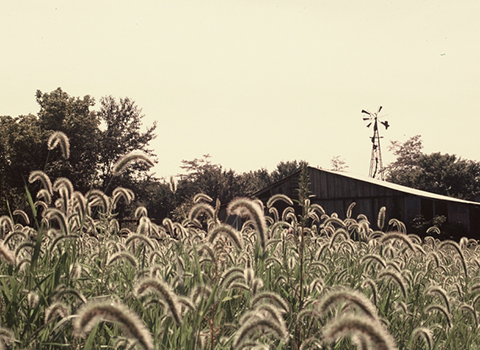
Bruce Family Farm, 1970s
Across all the objects, the signs contribute to a conceptual disconnect. For example, there is the red and white sign reading “Danger 66000-volts,” with skull and crossbones, that provides the roof, and an unexplained warning, to one of the churches. These signs are a sort of red herring, with messages that are often readable but that typically have no obvious relationship to the patterns and forms in space that Bruce’s constructions fundamentally represent.
More cryptic, perhaps, is what’s inside. The structures are mostly empty, he says, but sometimes he hides something in them. That adds to the mystery of these objects, which look a bit lived-in, a bit decrepit, yet lovingly maintained, a reminder of those old barns.